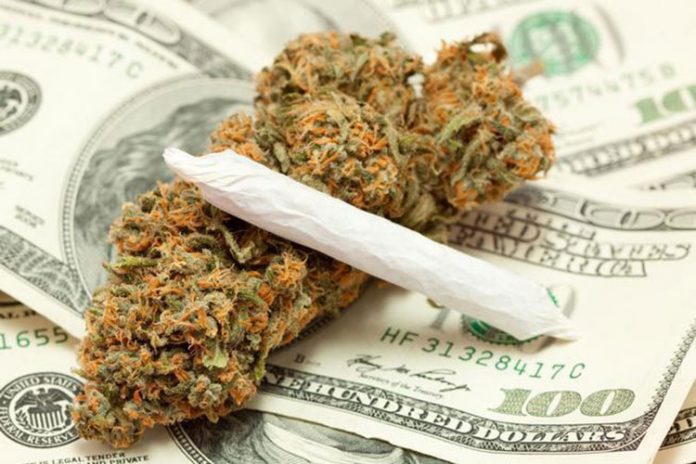You may not realize it, but the marijuana industry has come a long way in the United States in a relatively short period of time. In 1995, not a single state had approved the use of cannabis in any capacity and Gallup’s survey showed that only 25% of respondents favored the idea of legalizing weed nationally.
Fast forward to 2018, and we now have 29 states that have legalized marijuana in some capacity, including nine that have OK’d the sale of recreational pot, and Gallup’s latest poll (October 2017) found an all-time high 64% of respondents support legalization. That’s quite the about-face.
Despite the federal government retaining its Schedule I classification on the drug — meaning it’s wholly illegal, highly prone to abuse, and has no recognized medical benefits — the cannabis industry has thrived at the state level. For example, Colorado’s Department of Revenue tallied cannabis sales of $1.49 billion in 2017, up nearly 15% from the prior-year period and more than double what was reported in 2014, the very first year that recreational marijuana went on sale in the state.
Furthermore, Marijuana Business Daily’s 2017 report, “Marijuana Business Factbook 2017,” calls for U.S. cannabis sales to catapult to $17 billion by 2021. This is a result of new states such as California and Oregon selling cannabis, organic growth in existing states such as Washington and Colorado, and the expectation of additional states legalizing the drug.
As the U.S. marijuana industry expands, pot prices tumble
But what’s been really interesting about the expansion of the U.S. legal cannabis industry at the state level is what’s happening to wholesale cannabis prices. According to Denver-based independent price-reporting agency Cannabis Benchmarks, which developed its own price-tracking model for marijuana in legalized states across the U.S., wholesale marijuana prices are plunging — and they show little sign of slowing down.
After briefly touching $2,100 per wholesale pound in September 2015 and June 2016, wholesale cannabis prices have been, more or less, on an 18-month downtrend through the end of 2017. In 2016, the Cannabis Benchmarks U.S. Spot Index showed an average price of $1,789 per wholesale pound.
Last year, though, this dropped by 13% to an average of $1,562 per wholesale pound. Between late September and the end of 2017, wholesale cannabis prices ranged well below $1,500 per pound, signaling that more declines should be expected in 2018.
Why wholesale cannabis prices are declining
Though there’s no single answer as to why marijuana prices are dropping so precipitously, I believe three factors pretty concisely summarize why pot prices are dropping.
First, go ahead and lay the blame on ignorance. With the exception of Uruguay, marijuana is illegal in all other countries around the world. This makes it incredibly difficult for U.S. cannabis growers to figure out how much marijuana consumers will demand once recreational pot sales commence. There’s no precedent for growers to look upon, other than Washington and Colorado acting as guinea pigs for the rest of the nation in 2014, when adult-use sales commenced in their respective states.
It more or less means that growers in states with recreational cannabis laws are guessing on production, crossing their fingers, and hoping for the best. If they overproduce and create an intrastate glut of cannabis, it can drive down wholesale pricing.
Secondly, I believe it’s fair to suggest that blatant overproduction also is to blame for falling pot prices. While some growers will claim ignorance to demand projections, larger growers are liable to overproduce cannabis with two purposes.
First, flooding the market with marijuana may allow them to secure long-term supply deals with retailers, as well as forge emotional attachments with consumers. Also, and more importantly, overproducing marijuana can drive down prices and margins, making it unprofitable for smaller players to compete. By pushing smaller players out of the industry, larger growers are essentially securing their place — and profits — for the future.
Finally, I wouldn’t discount the idea that nostalgia and euphoria are playing a role. It’s not uncommon to see demand and tourism spike in the months following the commencement of legal weed sales. However, this initial euphoria typically doesn’t last too long. This drop-off in demand could be yet another reason why states like Oregon have dealt with oversupply issues following the kickoff of adult-use sales.
This is a trend worth monitoring
Personally, there’s no doubt in my mind that legal cannabis prices will eventually find a bottom, albeit I have no particular idea where that bottom might be or how quickly we’ll get there. It’ll likely depend on how effectively newly legalized states utilize supply-and-demand data from Colorado, Washington, Oregon, and even California when deciding how much cannabis should be produced each year.
A broader trend that I believe is worth keeping a close eye on is whether or not we witness the takeover by big business in the U.S. marijuana industry, just as we’ve seen in Canada’s pot industry. Bigger businesses have certainly made their mark, such as in Colorado, where they acquired most of a limited supply of growing licenses in recent years.
Big businesses tend to have deep pocketbooks and benefit from economies of scale, helping to keep their costs lower than smaller growing operations. These larger businesses may also provide a means for investors to make money. The current fragmentation of the U.S. cannabis industry is one of many reasons why investing in U.S.-based pot stocks simply isn’t a good idea.
Should we witness consolidation of the U.S. industry and see larger players emerge, it probably wouldn’t thrill enthusiasts who want to see marijuana legalized, but it would be a step in the right direction for investors looking to profit from ongoing state-level expansion.














